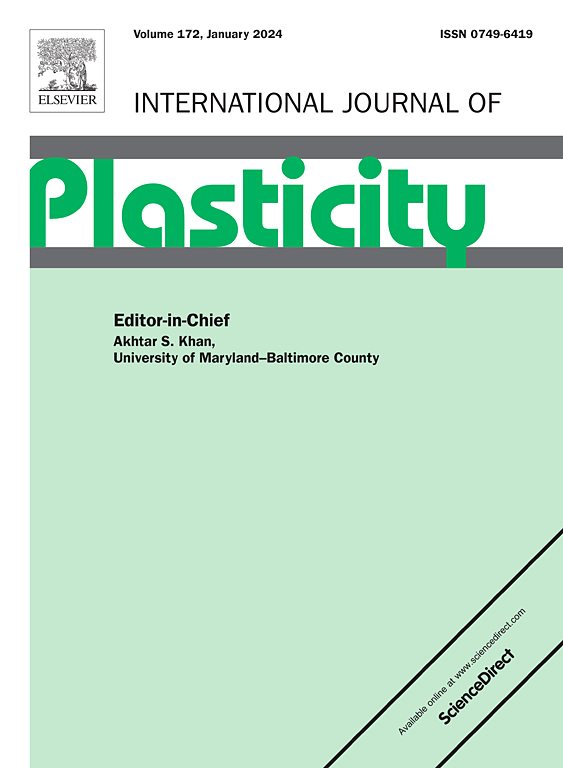Coupled phase field damage and crystal plasticity analysis of intragranular fracture: The role of crystallographic orientation and voids
IF 12.8
1区 材料科学
Q1 ENGINEERING, MECHANICAL
引用次数: 0
Abstract
Damage evolution in engineering metal alloys at the grain scale exhibits significant microstructural heterogeneity and anisotropy. These heterogeneities create local hotspots for stress and strain localization, leading to void nucleation. Crystal orientation influences the active slip systems around voids, affecting lattice rotation and potentially forming discontinuities. At low triaxiality, voids may change shape due to lower stress, rotation, elongation, and coalescence. At high triaxiality, the correlation between crystal orientation and void growth rate becomes stronger, resembling the behavior observed in isolated single crystals. Therefore, understanding the effects of crystal orientation, heterogeneous strain, and defect evolution is crucial for single crystal fracture characterization. In this work, a coupled phase-field damage (PFD) and crystal plasticity (CP) model is implemented within a finite element framework to analyze crystal deformation and failure. The CP method employs a dislocation density-based constitutive model, while intragranular failure is modeled using an anisotropic PFD method. The PFD model considers both the stored energy due to elastic stretching and the energy release due to defect formation and crack formation. A single crystal Al2219 with an intracrystalline spherical void is chosen to analyze fracture. The study finds that fracture propagation is strongly correlated with crystal orientations. This coupled CP-PFD model provides accurate failure prediction in crystalline materials by incorporating the effects of crystal orientations and existing voids. This study demonstrates how the local microstructure and defects influence plastic deformation and failure mechanisms in metal alloys.
晶内断口相场损伤与晶体塑性耦合分析:晶体取向和孔洞的作用
工程金属合金在晶粒尺度上的损伤演化表现出明显的组织非均质性和各向异性。这些非均质性为应力和应变局部化创造了局部热点,导致空洞成核。晶体取向影响空洞周围的主动滑移系统,影响晶格旋转并可能形成不连续。在低三轴性下,由于较低的应力、旋转、延伸和聚并,孔隙可能改变形状。在高三轴性下,晶体取向与空洞生长速率之间的相关性变得更强,类似于在孤立的单晶中观察到的行为。因此,了解晶体取向、非均质应变和缺陷演化对单晶断裂表征的影响至关重要。在本工作中,在有限元框架内实现了相场损伤(PFD)和晶体塑性(CP)耦合模型来分析晶体的变形和破坏。CP方法采用基于位错密度的本构模型,而晶内破坏采用各向异性PFD方法。PFD模型既考虑了由于弹性拉伸而储存的能量,也考虑了由于缺陷和裂纹形成而释放的能量。选取具有晶内球形空洞的单晶Al2219进行断裂分析。研究发现,裂纹扩展与晶体取向密切相关。该耦合CP-PFD模型通过结合晶体取向和现有空洞的影响,提供了准确的晶体材料失效预测。本研究揭示了局部组织和缺陷如何影响金属合金的塑性变形和破坏机制。
本文章由计算机程序翻译,如有差异,请以英文原文为准。
求助全文
约1分钟内获得全文
求助全文
来源期刊

International Journal of Plasticity
工程技术-材料科学:综合
CiteScore
15.30
自引率
26.50%
发文量
256
审稿时长
46 days
期刊介绍:
International Journal of Plasticity aims to present original research encompassing all facets of plastic deformation, damage, and fracture behavior in both isotropic and anisotropic solids. This includes exploring the thermodynamics of plasticity and fracture, continuum theory, and macroscopic as well as microscopic phenomena.
Topics of interest span the plastic behavior of single crystals and polycrystalline metals, ceramics, rocks, soils, composites, nanocrystalline and microelectronics materials, shape memory alloys, ferroelectric ceramics, thin films, and polymers. Additionally, the journal covers plasticity aspects of failure and fracture mechanics. Contributions involving significant experimental, numerical, or theoretical advancements that enhance the understanding of the plastic behavior of solids are particularly valued. Papers addressing the modeling of finite nonlinear elastic deformation, bearing similarities to the modeling of plastic deformation, are also welcomed.
 求助内容:
求助内容: 应助结果提醒方式:
应助结果提醒方式:


